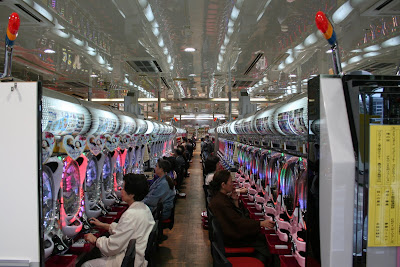Wednesday, September 26, 2007
Wednesday, September 19, 2007
Pachinko

Pachinko, a very popular pastime. I have tried it many times and I just can't see the appeal.
Pachinko - Japan's Favourite Game
By Ted Allen
Pachinko is an arcade or slot machine game that is particularly popular in Japan. There it is played in special rooms called Pachinko Parlors where you can find rows and rows of Pachinko Machines.
Pachinko is a similar kind of game to pinball but played on a vertical machine, and without the flippers you get on the sides of a pinball machine.
The player buys their pachinko balls and drops them into the loading area. They then start launching the balls, propelling them into the play area. The play area looks rather like that on a pinball machine, with a pattern of upright pins and a number of pockets or gates into which the balls can fall.
Vintage machines use a spring loaded metal flipper or lever to launch the balls. But modern machines fire the balls electronically. The player turns a dial that just controls the frequency with which they are launched.
Once launched the balls bounce around the playing area, hitting against the pins. Unlike in pinball, where the player can bat the ball around the play area using the flippers, in pachinko the player has no control at all over what happens to a ball once it has been launched.
Usually the ball will fall through the pins to the bottom. But sometimes it falls into one of the winning pockets. This gives the player a number of extra balls.
Most modern machines include a slot game which is triggered if a ball falls into a particular pocket. It is this game that gives the big jackpot wins, that is, large numbers of extra balls.
Players can choose to use the balls they win to keep playing, or exchange them for tokens or prizes such as pens or cigarette lighters. In Japan, cash gambling is illegal, so cash prizes cannot be awarded. To circumvent this, the tokens can usually be taken to a convenient exchange centre – generally located very close by, maybe even in a separate room next to the pachinko parlor.
As you can tell, there is very little skill involved in pachinko, especially in the modern machines where the only thing the player controls is the frequency with which the balls are shot onto the playing area. Apart from that it is purely a game of chance!
Article by Ted Allen of The-Pachinko-Guide.com The Pachinko Guide has a host of resources for Pachinko lovers, including;
Article Source: http://EzineArticles.com/?expert=Ted_Allen
Monday, September 17, 2007
Tuesday, September 11, 2007
Harajuku Girls
Gwen Stefani, lead singer of the pop band No Doubt, has lead a Madonna-esque fashion revolt in both her recent videoclip for her single What You Waiting For and her solo album Love, Angel, Music, Baby. Her catchy 80’s inspired popish tunes, platinum blonde hair and Like A Virgin kit out on the album cover art only reinforce her homage to the material girl, even though it may be somewhat tongue in cheek.
But its her references to the Japanese Harajuku Girls peppered throughout the album and on one track in particular that has drawn interest from a diverse range of commentators.
So who are these Harajuku Girls anyway?
The Harajuku District of Tokyo and in particular Takeshita Street, a narrow street lined with shops is home to these funky fashionistas. Since the end of World War II, “consumerism” and “consumption” have become the national past-time for most Japanese and in particular teenage girls who often live at home with their parents well into their twenties. Their rent free existence provides them with the enough funds to flock to Harajuku every weekend, where they transform themselves into Lolita-esque baby doll caracitures.
It’s all a sort of a pop-art meets pop-culture meets Western decadence kinda street where often a t-shirt with a western image like Mickey Mouse can go for several hundred dollars a pop. This constant pursuit of rock n roll pop star hipness extends to teenage boys too. They in turn have opted for the western inspired hip-hop culture of disheveled jeans hanging half way to their knees, caps at all angles on their heads and of course lots and lots of bling.
Often the net result looks like something out of a Manga comic book as the fashionistas of Harajuku compete to look less human and more iconic. Not concerned about what we in the West may see as a conflict of style over substance, Harajuku Girls unlike the Goths, punks and bond girls that came before are not about rebellion from society. No, in fact these girls, like most Japanese, are often extremely polite and happy to pose for photographs with inquisitive tourists who gather every Sunday to take happy snaps of these super-model caricatures.
For the Girls of Harajuku, their most extreme vice may be a simple cigarette.
Peter Shuttlewood is the author of webzine freshread which contains articles on Popular Culture with an Australian slant. Freshread - the everyday in a fresh way.
Article Source: http://EzineArticles.com/?expert=Peter_Shuttlewood




